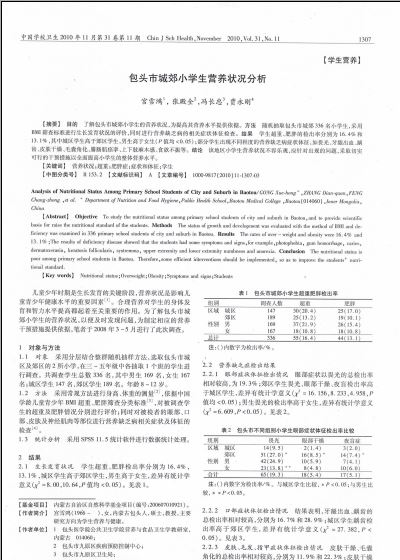包头市城郊小学生营养状况分析(1)
 |
| 第1页 |
参见附件(2093KB,3页)。
【摘要】 目的 了解包头市城郊小学生的营养状况,为提高其营养水平提供依据。
方法 随机抽取包头市城郊336名小学生,采用BMI筛查标准进行生长发育状况的评价,同时进行营养缺乏病的相关症状体征检查。
结果 学生超重、肥胖的检出率分别为16.4%和13.1%,其中城区学生高于郊区学生,男生高于女生(P值均<0.05);部分学生出现不同程度的营养缺乏病症状体征,如畏光、牙龈出血、龋齿、皮肤干燥、毛囊角化、腓肠肌痉挛、上下肢麻木感、食欲不振等。
结论 该地区小学生营养状况不容乐观,应针对出现的问题,采取切实可行的干预措施以全面提高小学生的整体营养水平。
【关键词】 营养状况;超重;肥胖症;症状和体征;学生
【中图分类号】 R 153.2 【文献标识码】 A 【文章编号】 1000-9817(2010)11-1307-03
Analysis of Nutritional Status Among Primary School Students of City and Suburb in Baotou/GONG Xue-hong*,ZHANG Dian-quan,FENG Chang-zhong ,et al. * Department ofNutrition and Food Hygiene,Public Health School,Baotou Medical College ,Baotou(014060),Inner Mongolia,China
【Abstract】 Objective To study the nutritional status among primary school students of city and suburb in Baotou,and to provide scientific basis for raise the nutritional standard of the students. Methods The status of growth and development was evaluated with the method of BMI and deficiency was examined in 336 primary school students of city and suburb in Baotou. Results The rates of over-weight and obesity were 16.4% and 13.1%;The results of deficiency disease showed that the students had some symptoms and signs,for example,photophobia, gum hemorrhage, caries, dermatoxerasia, keratosis follicularis, systremma, upper extremity and lower extremity numbness and anorexia. Conclusion The nutritional status is poor among primary school students in Baotou. Therefore,some efficient interventions should be implemented, so as to improve the students’ nutritional standard.
【Key words】 Nutritional status;Overweight;Obesity;Symptoms and signs;Students
儿童少年时期是生长发育的关键阶段,营养状况是影响儿童青少年健康水平的重要因素[1]。合理营养对学生的身体发育和智力水平提高都起着至关重要的作用。为了解包头市城郊小学生的营养状况,以便及时发现问题,为制定相应的营养干预措施提供依据,笔者于2008年3-5月进行了此次调查。
1 对象与方法
1.1 对象 采用分层结合整群随机抽样方法,选取包头市城区及郊区的2所小学,在三~五年级中各抽取1个班的学生进行调查。共调查学生总数336名,其中男生169名,女生167名;城区学生147名,郊区学生189名。年龄8~12岁。
1.2 方法 采用常规方法进行身高、体重的测量[2],依据中国学龄儿童青少年BMI超重、肥胖筛查分类标准[3],对被调查学生的超重及肥胖情况分别进行评价;同时对被检者的眼部、口部、皮肤及神经肌肉等部位进行营养缺乏病相关症状及体征的检查[4]。
1.3 统计分析 采用SPSS 11.5统计软件进行数据统计处理。
2 结果
2.1 生长发育状况 学生超重、肥胖检出率分别为16.4%,13.1%,城区学生高于郊区学生,男生高于女生,差异有统计学意义(χ2=8.00,10.64,P值均<0.05)。见表1。
2.2 营养缺乏症检出结果
2.2.1 眼部症状体征检出情况 眼部症状以畏光的总检出率相对较高,为19.3%;郊区学生畏光、眼部干燥、夜盲检出率高于城区学生,差异有统计学意义(χ2=16.156,8.233,4.958,P值均<0.05);男生畏光的检出率高于女生,差异有统计学意义(χ2=6.609,P<0.05)。见表2。
2.2.2 口部症状体征检出情况 结果表明,牙龈出血、龋齿的总检出率相对较高,分别为16.7%和28.9%;城区学生龋齿检出率高于郊区学生,差异有统计学意义(χ2=27 ......
您现在查看是摘要介绍页,详见PDF附件(2093KB,3页)。